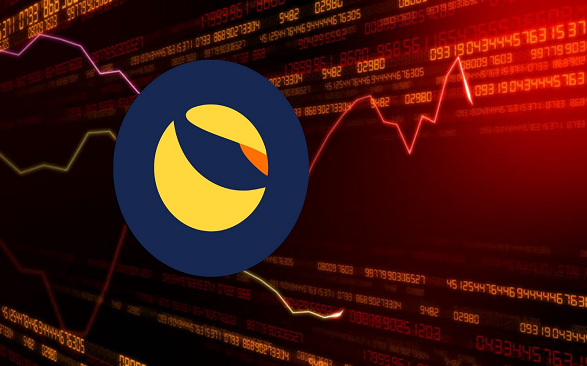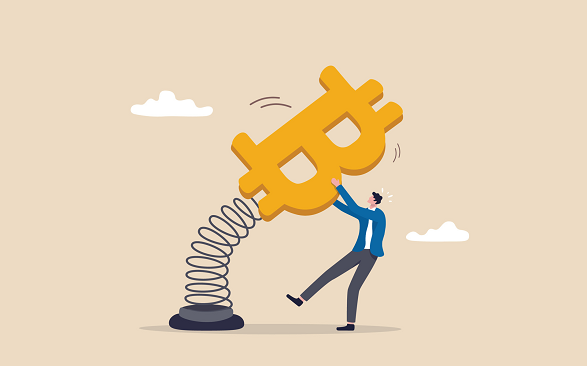Introduction
Terra is a public blockchain that deploys a suite of stablecoins powered by decentralization and algorithms. The Terra ecosystem comprises its stablecoin UST, its cryptocurrency LUNA, a smart contracts platform, and a cross-chain DeFi environment that interconnects between blockchain networks. Terra is built on the Cosmos SDK & Tendermint Consensus, leveraging the wisdom of the crowd and secure software for a decentralized community. The Terra ecosystem has more than 100 projects across DeFi, NFTs, and Web3.
Terra’s Glory Days
In April 2021, Luna had a market cap of over $40 billion, and was among the top 10 biggest cryptocurrencies, surpassing Polkadot and Avalanche, according to data from Coingecko. Luna even rose by over 12,000 percent in one year, starting from under $1 at the start of the year 2021. At its peak, it hit about $116. And this was just last month.

Terra’s reality today
Are the glory days over for Terra? Probably. Triggered by UST, the unprecedented crash of LUNA, Terra’s native cryptocurrency, has sent shockwaves across the crypto industry.
Terra’s destabilized dollar-pegged stablecoin TerraUSD (UST), got LUNA plummeting as mass panic and FUD kicked in. LUNA went from $80 on 6 May 2022 to almost worthless at the time of writing this report. LUNA price fell by over 99.98%. Although Luna Foundation Guard (LFG) started purchasing bitcoin to save UST from depegging, this did not work amidst the gradual crypto-market meltdown.

What really happened?
LFG and Do Kwon, founder of Terra, purchased around $3 billion worth of bitcoin. This effectively tied the success of the Terra ecosystem to the wider crypto market. When UST started depegging, the LFG and other market makers sold their bitcoin reserves in an attempt to stop the UST depegging. This sale had a massive ripple effect on the wider market, with bitcoin dropping below the $30,000 mark.
The last three days of the crash saw Terra’s Luna plummeting to an all-new low, with its stablecoin, UST, losing its peg.
Stablecoins are tightly pegged to a traditional fiat currency, such as the US dollar. Investors buy them to store money and seamlessly facilitate deals within the cryptocurrency infrastructure. They also are used for other types of financial exchanges, such as lending, borrowing, or facilitating cross-border payments with less friction than going through a traditional bank. Stablecoins such as USDT and USDC are collateral-backed stablecoins with their values being pegged to $1. This is unlike algorithmic stablecoins like Terra’s UST.
UST does not possess any collateral and only works through algorithmic smart contracts to maintain price equilibrium. The mechanism involves burning and minting UST/LUNA to retain price stability.
When a UST is minted, $1 of Luna is burned, and vice versa. When UST tilts below its peg, holders will sell their UST (or burn it) for $1 of Luna, making a slight profit. If UST rises above $1, the opposite will happen.
So when in the recent event UST lost its peg, holders rushed to sell. As holders sold, more Luna was minted, adding to the circulating supply of Luna. As holders of Luna sold in panic, Luna price dropped further. This meant that for every 1 UST sold, more Luna would need to be minted. After a large amount of UST was dumped, the stablecoin started to depeg. More UST was sold in a mass panic, minting more Luna and increasing its circulating supply. This had the knock-on effect of crashing the price of Luna. Effectively, supply significantly overtook demand.
Luna’s circulating supply is playing a major role in the unprecedented Luna crypto crash, as it continues to grow at an enormous rate. To give an example, if 1 UST was sold when Luna was at its all-time high of $110, it would mint just 0.009 Luna. However, swapping 1 UST for $1 worth Luna at the price of $0.000009 – its current price – would mint 111,111 Luna. Now try to extrapolate this across a $1 billion trading volume, and you can see why Luna supply has risen so fast and huge, therefore crashing the price value of Luna per coin.
Therefore, the circulating supply inflation of Luna has drastically increased. Previously, the circulating supply sat at around 343 million Luna. On May 12, it was 3.47 billion Luna, according to analytics data. By May 14, it is 6.5 trillion.
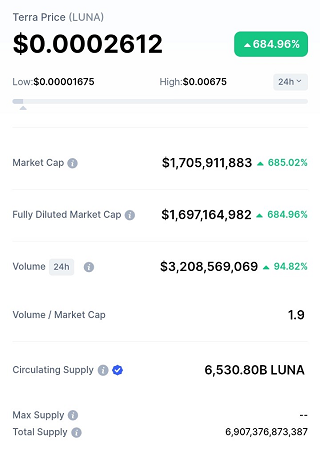
The unprecedented events in the Terra ecosystem have seen the price of Luna and TerraUSD collapse. At press time, the Terra LUNA is sitting at a market cap of billions, with its price plummeting to $0.000009. Alongside these issues, crypto exchange Binance has also halted LUNA and UST withdrawals citing network congestion and oversupply of LUNA which has exposed users to huge loss.
There is a recovery plan for Luna, says Do Kwon.
Terra founder, Do Kwon, still believes in the Terra project. In a Twitter thread, he encouraged the vibrant Terra community to remain vibrant and stay focused, working together with Terra to implement a recovery process.
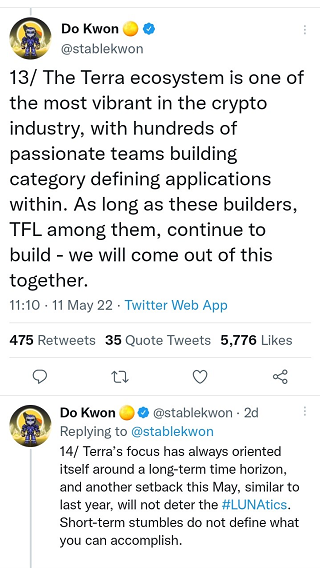
Do Kwon’s tweet about a recovery plan noticeably had a temporary effect on the overall market sentiment, but this was only temporary. Luna briefly rose to $4.46, before dropping below the $1 mark once again. Luna price has since plummeted below 1 cent.
According to Do Kwon, he will introduce a mechanism for collateralized UST in order to restore stability. Explaining why Luna and UST had dropped so dramatically in his Twitter thread, Do Kwon said that “[t]he price stabilization mechanism is absorbing UST supply (over 10% of total supply), but the cost of absorbing so much stablecoins at the same time has stretched out the on-chain swap spread to 40%, and Luna price has diminished dramatically”.
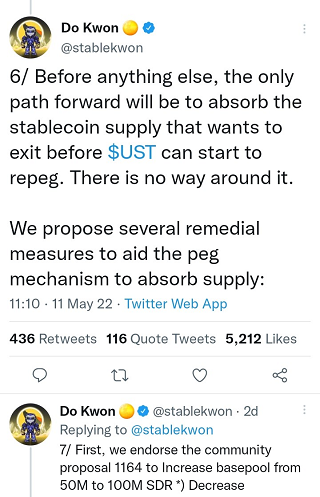
At the time of writing this report, LUNA price is fluctuating around $0.002767, coming up from a low of $0.00001675, with a market cap of $666,161,261 and ranking 206, according to CoinMarketCap.
But Binance has suspended LUNA and UST trading. According to Binance CEO, Changpeng Zhao (CZ), the reason for this decision is to protect consumers.
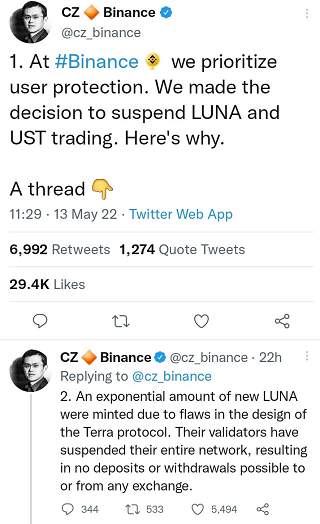
So whether LUNA will recover or not will largely depend on the level of trust and confidence the Terra community has in it as well as the level of support the general crypto space give to what was once the 7th biggest project in the crypto market.
Meanwhile, the crypto market currently appears to be bouncing back, with bitcoin returning tilting towards $30,000 and Ethereum returning above $2000. But FUD still pervades the market.
UPDATE!
LUNA hits $3billion in market cap! The recovery plan seems to have stimulated fresh hope in the Terra project.

Trade carefully.
The cryptoassetbuyer, investor, or trader is advised to trade carefully. Always apply appropriate risk management, and take profits where possible. The bulls and bears are forever in battle. Hence, we continue to closely watch the market to see if it makes a move, whether green or red. Keep a close eye on the market with CAB’s Crypto Market Live page where you can view price changes of several thousands of coins and tokens live.


